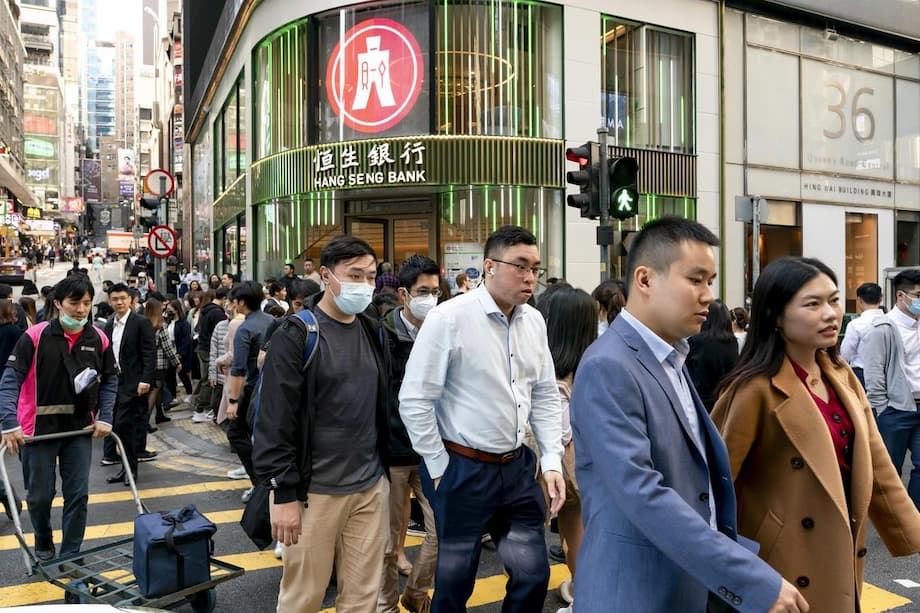A tighter job market meets a rapid migration shift
Recent graduate Mark Wong started sending out applications months before finishing his physics degree in May. Four months on, he still has not landed an entry role. He has broadened his search from data analysis and software engineering to jobs that do not require a degree, including an aviation security post, yet interviews remain scarce. He believes one reason is the wave of mainland Chinese workers arriving in Hong Kong, a trend he says has intensified competition for both professional and hourly roles.
- A tighter job market meets a rapid migration shift
- Policies behind the surge: TTPS and ESLS explained
- Are locals being displaced or is it a skills mismatch?
- On the ground: from airport security to finance, who is getting hired?
- Identity, attitudes and daily life
- Public services and resource concerns
- What could improve fairness and confidence
- What to Know
His worry taps into a larger shift. Hong Kong lost more than 5 percent of its roughly 3.8 million workers after the 2019 unrest and the pandemic period. In response, the government opened wider channels for non local recruitment, led by the Top Talent Pass Scheme (TTPS) for graduates and high earners and the Enhanced Supplementary Labour Scheme (ESLS) for semi skilled roles. Since 2023, mainland applicants have received the overwhelming majority of approvals. According to recent government figures, 95 percent of more than 111,000 TTPS visas and 97 percent of over 46,000 ESLS permits went to mainland Chinese. Labour Secretary Chris Sun said in mid August that roughly one in two TTPS holders has applied to extend the stay.
Alongside expanded intake, authorities have moved to reassure residents that local workers come first. In August, officials imposed penalties for the first time on companies that, after attracting public complaints, appeared to bypass locals in favor of cheaper imported labor. A cleaning firm received a one year hiring ban for rejecting a qualified local candidate and a restaurant received a two year ban after it dismissed local employees while hiring non locals. These actions landed as a tight job market sharpened frustrations for graduates like Wong and for mid career professionals who say they increasingly lose out to non local applicants.
Policies behind the surge: TTPS and ESLS explained
TTPS was designed to reverse talent loss and bring in high potential candidates quickly. It targets people with strong academic credentials or high earnings, including graduates from designated universities worldwide. The government says these recruits help fill skills gaps and energize sectors ranging from finance to technology. Mainland applicants make up the bulk of TTPS approvals, reflecting both proximity and the scale of China’s graduate pipeline. The high share of TTPS holders seeking to extend their stay suggests many are settling into the city’s professional ranks.
ESLS covers semi skilled roles where employers report persistent shortages, from restaurants to property management and logistics. The scheme requires firms to offer jobs locally first. Employers must show they cannot hire a suitable resident after a four week recruitment exercise and, in layoffs, imported staff must be retrenched before locals. The Labour Department says it conducts inspections, has set up an online complaint form and can bar employers that violate the rules, a power it exercised in the August cases.
Are locals being displaced or is it a skills mismatch?
Labor unions have warned that imported workers are displacing residents in some workplaces. Officials have acknowledged that investigations are under way. Chris Sun has said authorities identified two cases with preliminary evidence suggesting locals may have been dismissed after firms brought in staff from outside the city, while stressing that due process and appeals apply and that most complaints have not been substantiated. The government’s stated principle is to prioritize local employment and to allow importation only where vacancies cannot be filled locally.
Recruiters describe hiring as an employer market given weak growth and a wider pool of candidates. James Tan of NexusSearch International said that companies have raised requirements because they think they can find applicants who meet a longer list of skills. Many recent arrivals from the mainland, especially graduates from well known overseas universities, tend to be comfortable in both English and Mandarin and are familiar with mainland business culture. Benjamin Elms of Randstad Hong Kong added that in banking and other services, roles linked to overseas markets or that handle complex cross border business can favor candidates with regional or international experience. That does not translate to a blanket preference for non locals, he said, but it reflects the city’s pivot toward cross border and global work.
Another factor is the city’s technology shift. Digital transformation and the rapid spread of AI tools have changed hiring criteria across industries. Employers say they look for adaptable staff who can work with data, automation and new platforms from day one. Graduates with coding, data handling and cloud familiarity, or compliance specialists who understand regional rules, tend to pass more rigorous interview rounds. Hong Kong also faces a skills mismatch, so candidates who blend sector knowledge with language strength and digital skills often do better.
On the ground: from airport security to finance, who is getting hired?
In lower wage or semi skilled roles, the ESLS has allowed a rise in imported staff in cleaning, catering and security. Job seekers like Wong notice that Mandarin is widely used at the airport and in other customer facing roles, a sign of expanded mainland travel and business ties. Regulators say firms cannot replace locals with imported staff and must retrench imported staff first if layoffs occur. The August bans on a cleaning company and a restaurant signal that these rules carry consequences.
In finance, dynamics are mixed. A former bank officer named May, with about two decades of experience, says many openings now go to mainland candidates or to expatriates. Local professionals with strong networks in mainland or overseas markets remain competitive, yet many roles demand more than past experience. They increasingly require language range, cross border familiarity and tech comfort, as employers reorganize teams around mainland clients and international flows.
Research on labor market structure shows that vulnerability is not felt equally. A comparative study of precarious work in Hong Kong and mainland China found deeper segmentation in Hong Kong’s labor market. Part time, temporary and self employed workers in Hong Kong face larger wage penalties and weaker returns on education than in mainland China. That pattern helps explain why some locals accept less secure roles while searching for a foothold in better paying sectors. It also underscores why enforcement on displacement and investment in training matter for households already straining under high costs.
Identity, attitudes and daily life
The inflow of mainland talent arrives amid a broader demographic and cultural transition. According to the Migration Policy Institute, Hong Kong’s labor force shrank by roughly 140,000 people from 2020 to 2022, a period marked by emigration of young professionals and families. Net immigration then helped lift the population by 2.1 percent from June 2022 to June 2023, driven largely by arrivals from the mainland. These trends are reshaping workplaces and neighborhoods, tilting language use toward Mandarin in some districts and changing consumer tastes. A feature on Lan Kwai Fong described new mainland brands, menus and entertainment options in a nightlife area long associated with expatriate culture, signaling how daily life is adjusting to new patrons and entrepreneurs.
Attitudes among young people also reflect change. A randomized study of Hong Kong and mainland university students found that local students reported cooler views toward mainland peers than the other way around. A one day workshop improved knowledge about the other group, yet did little to shift attitudes or intended behavior among locals. The findings suggest that identity change and trust building take time. Universities and employers that create more contact and cooperation may help reduce friction in classrooms and offices.
Public services and resource concerns
Former chief executive Leung Chun Ying has urged greater transparency on how imported labor affects public resources such as schooling, housing and healthcare. Officials maintain that the city needs targeted importation to keep services running and to support growth while the local pipeline rebuilds. Public acceptance hinges on credible oversight. Clear reporting on where imported workers go, how long they stay and whether redundancies follow can help residents see whether safeguards are working.
Cross border use of services presents a policy challenge. A study in Humanities and Social Sciences Communications outlined how the “one country, two systems, three legal jurisdictions” framework complicates healthcare collaboration among Hong Kong, Macao and mainland China. Financing models differ, benefit portability is limited and rapid integration can strain supply if usage jumps. The paper recommends a fiscal compensation mechanism and agreed principles for portability, informed by international practice, to avoid shifting costs onto any single system. As infrastructure deepens links with the Greater Bay Area, including plans for the Northern Metropolis and existing bridges and rail, policymaking on shared services will need careful pacing and clear cost sharing to protect access and quality.
What could improve fairness and confidence
Three levers stand out. First, consistent enforcement. Regular inspections, a responsive complaint channel and timely sanctions deter corner cutting. Publishing case summaries, sector specific audits and a list of sanctioned employers can build trust. The ESLS rule that imported workers are first to be retrenched in layoffs should be monitored through random checks and worker interviews. Employers that breach the local first principle could face longer bans on importation and be required to remedy harm, including back pay where appropriate.
Second, invest in people. Subsidized training in data, AI tools and cloud platforms, paired with industry designed curricula, can help graduates and mid career workers meet evolving demands. Employers that benefit from importation can co fund training places, internships and apprenticeships for residents. Language support matters in both directions. Stronger Mandarin for locals expands opportunities with mainland clients and Cantonese training for new arrivals supports service quality and social integration. Targeted support for sectors with shortages, including healthcare and skilled trades, can shorten hiring queues without depressing wages.
Third, improve transparency. A public dashboard that shows approvals and renewals by sector, salary band and job family would let residents see where shortages persist and where reliance on importation is falling. Clear shortage occupation lists, reviewed frequently with union and employer input, can guide both visa policy and training funds. Requiring employers to document domestic recruitment efforts and to publish pay ranges can deter substitution of locals with cheaper non local hires.
What to Know
- Since 2023, mainland applicants received about 95 percent of more than 111,000 TTPS visas and 97 percent of over 46,000 ESLS permits, according to government data.
- Roughly half of TTPS holders have applied to extend their stay, Labour Secretary Chris Sun said in mid August.
- Authorities issued their first penalties in August for bypassing locals, banning a cleaning firm for one year and a restaurant for two years from hiring imported labor.
- Government rules require local first hiring, a four week domestic recruitment period and retrenching imported workers before locals if layoffs occur.
- Recruiters report an employer market with higher hiring bars and a tighter focus on language, cross border familiarity and digital skills.
- Mid to senior level professionals feel the greatest pressure from competition, while junior roles are more insulated.
- Hong Kong’s labor force fell by about 140,000 from 2020 to 2022, then population rose 2.1 percent from June 2022 to June 2023 on net immigration.
- Studies show local students hold cooler attitudes toward mainland peers than the reverse, while knowledge can improve with contact.
- Research indicates deeper labor market segmentation in Hong Kong than in mainland China for precarious workers, intensifying wage penalties for part time and temporary roles.
- Calls for transparency include tracking resource use in education, housing and healthcare and clarifying cost sharing as Greater Bay Area integration advances.




